
Dock of the Bay

Volume VII Number 24
June 17-23,1999
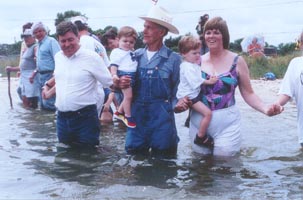 Looking Good - More Leg Seen on Bernie's 12th Annual Wade-In
Looking Good - More Leg Seen on Bernie's 12th Annual Wade-In
Bernie Fowler and friends wade into the Patuxent. photos by Mark Burns
Looking down at retired state senator Bernie Fowler's soggy feet, you could see his big toes wiggling through small, tattered holes in the canvas shoes. They looked weathered, stained lightly with the greenish brown tint of Patuxent River.
The shoes, not the toes.
"They're getting in kind of bad shape, the holes in them and all," said Fowler of the sneakers on his feet, "but they're still useful. I get a little ventilation that way."
Besides, you just don't get rid of the shoes that have become something
of an icon for the Bay's environmental movement. There are people who itch
to bronze those very sneakers. The Maryland Tributary Teams have even modeled
an award after Fowler's fabled footwear - a pair of sneaks mounted on a
fine piece of wood and given to someone deemed deserving at the annual Tributary
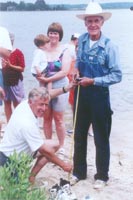 Strategy meeting.
Strategy meeting.
"These are the original ones," said Fowler, glancing down at
his sneakers. "I bought them brand new the first year we waded in."
That was 12 years ago; he's worn the same shoes exclusively for the wade-in
every year since. Using them, Fowler has established the Sneaker Index,
a non-scientific measure of water clarity based on how deep Fowler can go
into the Patuxent before his shod feet disappear in the murk.
Congressman Steny Hoyer measured a 41.5"-high waterline on Fowler's overalls after Sunday, June 13's wade-in - a six-inch improvement over last year. The showing of people was smaller, though; perhaps half of last year's turnout of nearly 100.
Nevertheless, Fowler was far from lonely among family, friends, school kids and community supporters.
Many others joined him in spirit from afar. Waders from nine of the 10 Maryland Tributary Teams could be found on either shore of the Chesapeake testing waters at Herring Bay, Otter Point Creek, Potomac River and Nanticoke River. Carrying the torch in their own way were Secchi-disk dippers at Baltimore's Inner Harbor and anglers at the rapids of Rocky Gap Park. Still to come are wade-ins on June 19 at the Horsehead Environmental Center on the upper Eastern Shore (10:30-3:30) and in the Tred Avon River at Oxford (9am).
Fowler is encouraged by the widespread imitation. "I think it's good, because the whole purpose, really, is to focus serious attention on the conditions, on the water quality," he said. All nine of the Maryland Tributary Teams who have followed Fowler's footsteps into tributary tidewaters have found success in piquing communities' interest on the issue.
Congressman Steny Hoyer measures the "Sneaker Index" - the depth to which Fowler could see his sneakers and a gauge of the Bay's overall clarity.
"The Patuxent is now an example of what can be done, and what one man can do," said state Sen. Roy Dyson in his speech at the Patuxent wade-in, echoing a common refrain spoken by all who took the podium that day. Fowler's sogged soles have earned him much such praise, including the recent honor of the Jug Bay Award.
The Friends of Jug Bay Wetlands Sanctuary handed Fowler the token of their esteem - a hand-made, personalized clay jug - in a ceremony on May 22 to honor his environmental record. "Of course, you're always flattered when something like that happens," said Fowler. "Just another way to encourage you, I guess. Keep your ego pumped so you can keep going, you know."
And keep going he will. Fowler's wish is to venture out each year in those same shoes, sans bronze, until, as in the good old days, he can watch his toes wiggle through chest-deep water.
-Mark Burns
Could you use a few thousand trees? To be exact, 8,400?
American Forests is seeking 20 acres or so to be home to the forest of Chesapeake Country native trees New Bay Times readers and supporters bought at our Sixth Birthday Bash in May.
We chose trees as this year's beneficiary because they play such a role in the quality of Bay life. Trees absorb rain and run-off, soaking up nutrients and other potential pollutants before they wash into the Bay and its many tributaries. Tree roots prevent erosion, keeping our waters clear. Trees also produce oxygen, filtering the air we breath.
But over the last 30 years, deforestation in the Bay watershed has been alarming, satellite data show.
"Something as simple as planting a tree can make a difference," said NBT General Manager J. Alexander Knoll in announcing American Forest as this year's birthday partner. "Working together we can make a big difference."
American Forest has committed to plant one million trees in the Bay watershed by year's end. At midyear, they're at least three-fourths of the way there.
Now it's time to work together again, in finding the right spot to plant our little forest.
The ideal spot will be in Anne Arundel or Calvert County, NBT's main distribution areas. To meet American Forests' Global ReLeaf criteria, it should also be a distressed area, whose forest ecosystem has been damaged by wildfire, hurricanes, tornadoes, insects, diseases, misguided treatment by humans or other causes.
If your project protects endangered or threatened plants, animals or ecosystems, so much the better.
"Global ReLeaf prides itself on planting the right tree in the right place," says Karen Fedor, director of the program. "Since 1990, we've planted more than nine million trees on 120 Global ReLeaf Forests in 41 states. More than 16,000 acres of that land was considered difficult to plant."
The land must be government owned or "public-assisted private land meeting special criteria." Funds for planting the area should not be available from regular programs or sources.
With American Forests paying $1 per tree, re-leafing competition is keen. You improve your chances, Fedor notes, by "leveraging local support for a lower cost per tree and maximizing the number of trees planted for the funds available."
While American Forests pays for the trees and all that's needed to prepare the site, you'll do the work, supplying planters and professional expertise to maintain the forest. In your planting crew, you can count on volunteers from the extended NBT family.
American Forests also favors "new or innovative efforts, restorative approaches or technologies that have the potential for application elsewhere."
Think you've got the right spot and the right stuff? Apply to Global ReLeaf Forests by July 1. Let NBT know, too, so our reader-planters can be looking ahead to their next call to work together to make a difference in the quality of Bay life.
Learn more - and, if you choose, apply on line - at www.americanforests.org. Or call Karen Fedor at American Forests at 202/955-4500 x 224. All applicants will be notified by September 1 for fall planting.
Photo from Stanley Turrentine, More than
a Mood.
With the coming of summer, Friends of the Annapolis Sy mphony have the town marching to the beat of a different drummer. Leaving the sounds of classical music for cooler months, Friends annually liven up Annapolis with jazz. This year, they've headed their lineup with nationally acclaimed jazz men and women.
In seven years, JazzFest has helped the Friends contribute $100,000 to the Symphony. The Fest funds an education program that brings the orchestra to Anne Arundel County schools to introduce third graders to classical music.
But on festival day - Father's Day this year, June 20 - nobody cares about anything but good music and outdoor fun.
JazzFest promises both and to saturate you in high-class jazz, with Stanley Turrentine, Vanessa Rubin, The Cecilia Smith Quartet, The Rumba Club, Dave Burns and Hot Mustard and The Guitar All Stars.
Four-time Grammy nominee Stanley Turrentine headlines the show. Turrentine, who perfected his music in New York, settled in Fort Washington six years ago.
"It's serene and there are so many things you can do," Turrentine told NBT. "The area is accessible to every place; airports are around and it's very close to cow country. A friend of mine has a 36-footer and we go out fishing on the Bay."
Serene surroundings are a necessity for a player on the go.
"I'm going in August to Japan for a week. Then me and Ray Brown, who plays bass, are touring with Oscar Peterson and his 20-piece band. We're playing three cities in Canada - Montreal, Ottawa, Vancouver - and three cities in the states - San Francisco, Chicago and New York."
Turrentine is not the only performer familiar with the high road of jazz music.
Vocalist Vanessa Rubin - another nationally recognized name in jazz circles and hot on the heels of her fourth CD release - promises to thrill with her sultry style reminiscent of legends Sarah Vaughn and Nancy Wilson.
In the past, JazzFest has drawn a good crowd from the Annapolis area, said Cheryl Goodman, publicist for this year's event. But the Friends were looking to capture a bigger audience, Goodman said, so she has sought musicians like Turrentine and Rubin with a broader appeal geographically.
The day-long Festival promises to please audiences of all ages, offering more than just good music.
The morning begins at 10 with two workshops for local musicians, students and interested spectators.
Reuben Jackson, a jazz critic, leads a multi-media discussion on Duke Ellington.
Vibist Cecilia Smith leads a second morning workshop.
As the country's only female recording jazz vibraphonist, she shares her thoughts on the challenges of being a woman in the male-dominated world of jazz.
Once the workshops end, the music begins at 12noon straight up.
Children can dance to the beat of the music or stand in line for face painting, coloring games and balloons. Even the Baltimore Orioles Bird is on the scene to greet children and guest performers.
The Hot Mustard Jazz Band, one of the hottest party bands in Washington, D.C., gets the festival started. Before the band marches on-stage, they trolley around historic Annapolis, tempting Annapolitans with their fiery sounds.
Beware, because once they arrive, it may be hard to settle in one spot. Dixieland and big band swing sounds will have you moving.
Switch gears when Latin rhythms fill the afternoon air. Baltimore's The Rhumba Club hits the stage with the hot sounds of rumba, meringue, mambo and cha cha.
After conducting a morning workshop, Cecilia Smith and her quartet wow the crowd with their talent.
A love of music is at the root of all Smith's activities, whether giving a rousing performance at the John F. Kennedy Center's Women in Jazz Festival to accepting an invitation to visit Cornell University as guest clinician and lecturer.
The smooth sounds of JazzFest will be interpreted by yet another group, The Guitar All Stars. This quartet features guitarists Steve Abshire, Paul Bollenback, Paul Wingo and Royce Campbell.
Recording artist Rubin rounds out the list of musicians performing before Stanley Turrentine. Having thrilled standing-room only audiences, Rubin is bordering on the edge of diva-hood.
When legendary Turrentine climbs the steps to the stage, Annapolis is promised the performance of a lifetime.
For over 50 years, Turrentine has played with the jazz's best. John Coltrane recommended Turrentine to fill his vacant seat in the Earl Boostic Big Band. Today, he's at the top of the charts.
Jazz is Turrentine's life.
"I've never done anything else, and I've never intended on doing anything else," Turrentine says. "I've been blessed. I started playing at nine when my father put the saxophone in my hands. My whole family played music. That was our way of entertaining ourselves."
"I recently released my first album in five years. It's hard to find something new to play when you've been playing as long as I have. We finally got it together and we have high hopes with this album, Have You Gotten the Sugar? We've even gone toward the popular phase of the music. We think we've gotten into the straight-ahead, the rhythm & blues, the whole gamut," Turrentine says.
To groove the crowd in Annapolis is his next goal.
"I've got a nice little quartet and we've been playing together for a while: Paul Thompson on bass, Lenny Johnson on drums and Mike Davis on piano," Turrentine says.
Bring your blanket and picnic or choose from food sold on site for a perfect afternoon on the banks of College Creek.
With a laugh, Turrentine promises, "we're going to have some fun."
-Mary Catherine Ball
Music begins at noon June 20 on the banks of College Creek on the lower campus of St. John's College, Annapolis. Park in government lots off Rowe Blvd: $20 w/advance discounts: 410/269-1132.
Local Heroes Restore South Arundel Landmark
photos by Mary Catherine Ball Marjorie and Gordon Sherbert, below, have worked their roadside produce business for 21 years. Volunteers Susan Reed, above, Evelyn Helvey and Faye Bush and others from West River Long & Foster pitched in to put the sparkle back in the produce stand.
Most days this year as for 40 years, Marjorie and
Gordon Sherbert do the work, selling local produce and catches from strawberries
in spring to oysters and muskrat in winter.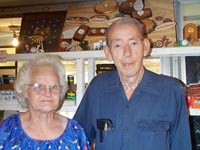
For 21 years, their handmade signs announcing Silver Queen corn, watermelons, cherries and apples have called to the traffic that travels Route 2 in the farthest southern reaches of Anne Arundel County.
June 9 they got a day off.
That day the associates of West River Long & Foster Realtors swept in to restore the landmark produce stand. Trading in suits and dress for khaki shorts and short-sleeved polos were branch manager Colleen Pearsall, associates Faye Bush, Linda Crandell, Tony Eller, Evelyn Helvey, Carol Martin and Susan Reed and administrative assistant Anita Lewis. Andy Pappamihiel arrived with wife Carolyn, and Pearsall worked with husband Wes and sons Theo and Tommy.
Long & Foster scraped paint, swept, rebuilt shelves, replaced ceiling boards, rebuilt the trailer that displays produce and repainted the building and signs.
It was, everybody agreed, about time.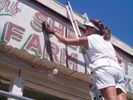
At 71, Gordon has been plagued by ill health. In the past, he's trooped on, past everything that stands in his way. But this year, both Sherberts knew he'd not be up to making the repairs.
"I say it's well deserved and well needed. My husband just can't do it anymore," Marjorie Sherbert said.
Long & Foster's Susan Reed saw that the Sherberts needed help.
"I live around the corner and buy the family Christmas tree there every year. I've been wanting to do this for a couple of years. I wanted to do something in our community, helping the people who live here. If we lose our family-owned businesses, Maryland loses its character," said Reed, coordinator of the Sherbert project.
In a region under siege by change, the Sherberts and their produce stand are one of life's constants.
The family has deep roots in Southern Anne Arundel County. Marjorie was
born in Tracey's Landing on September 8, 1930. At four months, Marjorie
and her family moved to Owings where she remained until her marriage to
Gordon.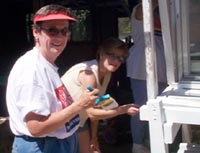
Gordon was born June 6, 1928, and raised on Bayfront Road in Lothian.
With not much distance separating Gordon and Marjorie, it was no surprise the two met.
"I went to my neighbors to get a crock pot for cooking. I was walking down the avenue with the crock pot. Four guys pulled up and asked if I needed some help. Of course, they all asked me out. When it got to Gordon, I said yes," Marjorie says, a coy smile forming on her face. "We got married on April 1, April Fool's Day, and he's been fooling me ever since."
Together, the Sherberts made the Fairhaven area their home.
In 50 years of marriage, Marjorie says their life did not always center on growing and selling produce.
"Before I raised vegetables, I raised children," Marjorie says, with a laugh.
Margie, Darlene, Brenda and Pam came into the world in a span of five years, keeping Marjorie on her toes. Today, with several nieces, nephews, grandchildren and great-grandchildren added to the family, the Sherberts remain closely knit.
Sherberts as all know it started on Fairhaven Road with a couple of vegetables sitting on a tabletop.
"We had corn, tomatoes, a pepper now and again. We'd sell from a tabletop. But corn was our calling card. My husband could grow some corn," says Marjorie Sherbert, remembering the old days. Gordon no longer grows their wares. He travels twice a week to the Hughesville market in St. Mary's County.
After 18 years of working on the farm and a tabletop, the Sherberts opened a little fruit stand. Then both home and stand moved to Rt. 2.
After 40 years, Gordon and Marjorie Sherbert still rise early and prepare for the day's business. The stand opens at first light and closes at the first sign of night. The people - locals and Bay boaters who pull into the circular drive to buy fresh goods - Marjorie says, are the reason she continues to sit at the stand, year after year.
Community service is also a tradition for Long & Foster.
Each year, all Long & Foster offices close down for one day to perform community service projects.
Colleen Pearsall explained corporation co-founder Wes Foster's interest in serving the community.
"Wes Foster is really big on community service. He feels we should give back to the community. He got to VMI on scholarships. Once he became successful he wanted to give back. Last year, we gave away $61,000 in scholarships," Pearsall said.
Last year, the same office tackled a project at the Chesapeake Wildlife Sanctuary: building pens for animals, improving the roads with gravel and painting the main building.
When Pearsall sought out donations for this year's project, local businesses didn't let her down.
Deale's Herring Bay Paints and True Value provided paint brushes and supplies, while Food Rite offered cleaning supplies. Churchton's Smiths Lumber, Owings' Sneades Home Center and Dunkirk Supply donated lumber.
Hard work should not be without reward. West River's Paceway provided refreshments.
"It makes us feel good to do something for other people who need it. Long & Foster is community oriented. I'm proud to be a part of the company," said associate Helvey.
With the sun rising higher in the sky, Long & Foster labored, alternating tools with towels to wipe their brows.
By day's end, the restored produce stand wore a coat of freshly painted color. Gordon and Marjorie Sherbert - who can remember once closing the stand for a day, long enough to relax but not too long to upset the local routine - beamed.
-MCB
In Our Little Bay Ponds
At Captain Salem Avery House, Dalys Release Helm
photos by M.L. Faunce George
and Mavis Daly, seated, have together steered the Shady Side Rural Heritage
Society as co-presidents for the past six years. They presided over their
last Monday meeting June 14.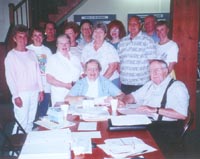
Six years ago, Mavis Daly gave a State of the Society address when she and husband George took the helm of the Shady Side Rural Heritage Society as co-presidents. So it was only fitting, Daly said, to give a Farewell Address as she presided over her last Monday morning board meeting at the Captain Salem Avery House Museum on June 14.
Daly thanked board members and spoke of "the marvelous experience that has given purpose and meaning to my life. I shall miss it greatly," she said, "and stand willing to help whenever you need me in the future."
With that, Daly gaveled in the first order of business, asking Secretary Lynne Kitzmiller to read the minutes of the last meeting and directing Board Member and Treasurer LaVerne Papian to "cash the CD and pay off the mortgage" of the Captain Salem Avery House, one of the Dalys' top priorities during their presidency.
George Daly, who also served as chair of buildings and grounds, reported on a final piece of business as well.
"The flag pole was taken down, painted, rope replaced. It's in good shape for the Fourth of July," he proclaimed, having presided over countless other nuts-and-bolts matters, both large and small, on his call. And on this day, Flag Day, George Daly proved once again his dedication to detail and to maintaining and caring for the waterman's house originally built in 1860.
For the Dalys, six years at the helm of the Heritage Society translates into about 312 Monday mornings, minus a few holidays, spent gathered around a table with a group described as "closely knit" to carry out the job of historic preservation. With views of the West River over their shoulder, board members - including past president T.C. Magnotti - roll up their sleeves and apply their considerable talents and expertise to produce a museum that many admirers are quick to observe has no equal in the area.
Attendance at board meetings is the tip of the iceberg for this dedicated board, who throughout the year pull together a multitude of events, exhibits, educational programs, an auction, luncheon series, a regatta and holiday parties, while keeping their eye on the prize: the continued development of a first-class small museum that celebrates life around and on Chesapeake Bay.
Among the last orders of business for the day, Mavis Daly introduced volunteer Deborah Judy, who presented options for a new homepage for the Society. Faithful to the promise in her farewell address, Daly was the first to volunteer to serve on the committee to study the options and make recommendations to the board. No one seemed surprised.
-M.L. Faunce
Delaware and New Jersey both will host efforts to count horseshoe crabs on 16 Delaware Bay beaches in an effort to develop a coastal management plan for the species. Conservationists say that overharvesting for bait and biomedical research seriously threatens horseshoe crabs ...
In Washington, D.C., a debate later this month will focus on which is more important: birds or your cell phone. Scientists estimate that each year, communications towers kill four million birds that strike the towers or become disoriented by lights. The meeting in D.C. between conservationists and industry groups is the first step toward solving the problem ...
In Virginia, the Army Corps of Engineers has issued a rare pro-environment ruling. The corps said last week a proposed reservoir in King William County was a bad idea because it would flood ancient Indian campgrounds and threaten the Mattaponi River ...
Lake Michigan is enjoying a fish resurgence similar to the Chesapeake Bay striped bass recovery. Yellow perch are coming back after commercial fishing for them was halted in the mid 1990s, researchers say ...
In Norway, a bird-loving woman is using the cleavage between her breasts to incubate the egg of a rare curlew, the Philadelphia Inquirer reports. The woman said she keeps the egg there at all times, even at night, and has told her husband to keep away so as not to crack the egg ...
Our Creature Feature comes to us from California, where they need to take a lesson from Maryland's Eastern Shore. The Sacramento Steelheads, a minor league baseball team, is getting heat for its between-inning fun of selecting fans for a competition in heaving dead steelhead trout.
In Vienna, Md., at the annual Shad Festival, contestants fling non-living fish - but only a soaked foam variety.
The owner of the team owner says he plans to conduct a crowd poll "to decide whether the fish toss is harmless entertainment or borderline animal abuse."
| Issue 24 |
Volume VII Number 24
June 17-23, 1999
New Bay Times
| Homepage |
| Back to Archives |